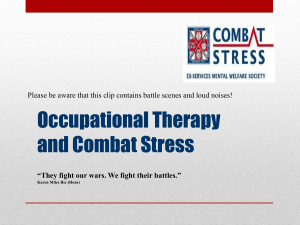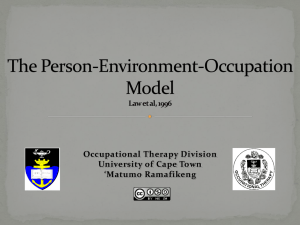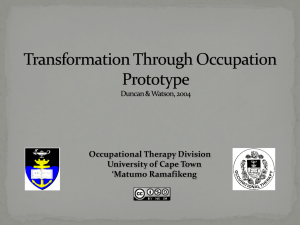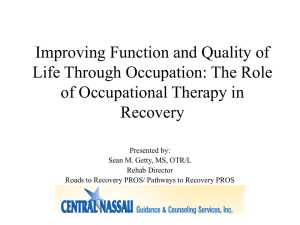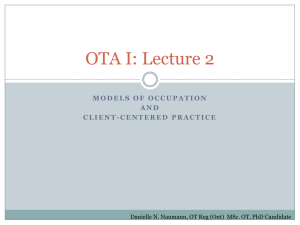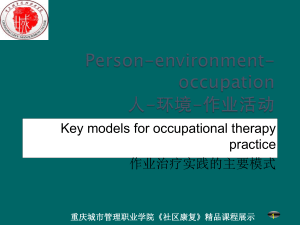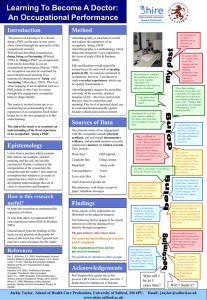Home Assessments - Denis Anson`s DeskWeb
advertisement
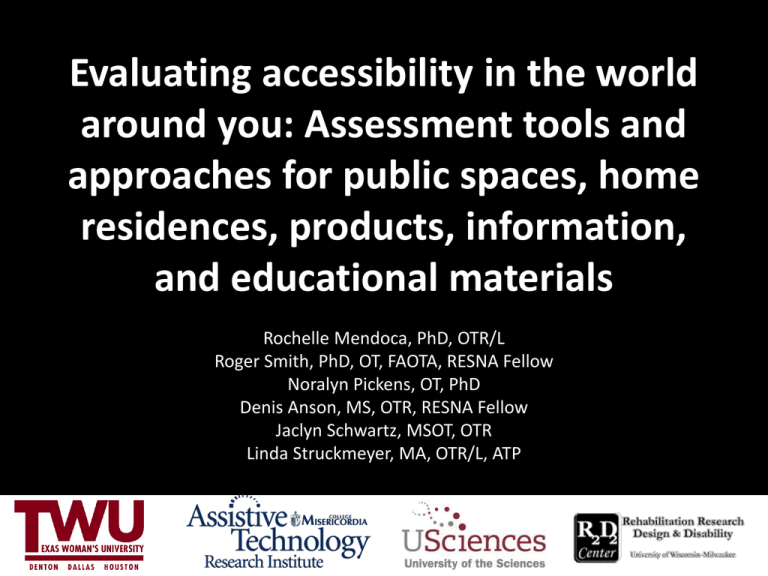
Evaluating accessibility in the world around you: Assessment tools and approaches for public spaces, home residences, products, information, and educational materials Rochelle Mendoca, PhD, OTR/L Roger Smith, PhD, OT, FAOTA, RESNA Fellow Noralyn Pickens, OT, PhD Denis Anson, MS, OTR, RESNA Fellow Jaclyn Schwartz, MSOT, OTR Linda Struckmeyer, MA, OTR/L, ATP Agenda • • • • • • • • Introduction Overview of accessibility and universal design Residential spaces Public spaces Information accessibility Learning and education accessibility Product accessibility Wrap-up Residential Assessments Approach • • • • • Context of evaluation provision Degree of client – centeredness Degree of PEO Skills of therapist/evaluator Range of tools – Availability Acute Care Rehabilitation Home Health Care Home Mod Specialist AARP COUGAR SAFER-HOME HEAP I-HOPE WESTMEADE CASPAR AARP Home Safety Checklist Purpose: Assess safety and comfort of home for well elderly with minor impairments Context for assessment: Acute, Rehab, HH PEO: Occupation orientation Developed: Updated 2011, caregiver checklist 2007 Description: Client assesses accessibility and safety of home by answering questions such as “Are cabinets and cupboards easy to open?”; if the answer is “no”, suggestions for improvements or modifications are made. AARP. http://www.aarp.org/home-garden/livable-communities/info-07-2011/make-your-home-a-safe-home.html SAFER-HOME v3 Purpose: Assesses client’s ability to safely carry out functional activities in the home and evaluates effectiveness of modifications as an outcome measure Context for assessment: Rehab, HH PEO: Occupation orientation Developed: 2006 (v3) Description: Using interview and observation of client participating in activity, assesses 75 items around the home; level of safety risk is scored on a 4point (0-3) scale Chiu, T., & Oliver, R. (2006). Factor analysis and construct validity of the SAFER-HOME. OTJR: Occupation, Participation & Health, 26(4), 132-142. Home Environment Assessment Protocol (HEAP) Purpose: Assesses home environment of people who have dementia for safety hazards and provides recommendations for home modification Context for assessment: Rehab, HH PEO: Person centeredness revolves around caregiver, Occupation centered , environment is considered a treatment modality Developed: 2002 Description: Information on 192 items in eight areas of the house are rated through caregiver interview, direct observation with caregiver clarification, and direct observation ; presence or absence of safety hazards, adaptations, visual cues, and comfort are scored as present or not Gitlin, L ., & Corcoran, M. (2005) . Home Environment Assessment Protocol (HEAP) Assessment in Occupational Therapy in Dementia Care. Bethesda, MD: AOTA In-Home Occupational Performance Evaluation (I-HOPE) Purpose: measure in-home activity performance and change in fit of P-E before and after home modification interventions Context for assessment: Rehab, HH, Home mod specialist PEO: client-centered/occupation orientation Developed: ©2011 Description: card sort followed by prioritizing, identifying level of satisfaction and observation of activities, identifying barriers to participation Stark, S. L., Somerville, E. K., & Morris, J. C. (2010). In-home occupational performance evaluation (I-HOPE). American Journal of Occupational Therapy, 64, 580-589. doi: 10.5014/ajot.2010.08065 I - HOPE Westmead Home Safety Assessment (WeHSA) Purpose: Systematically identify fall hazards in a client’s home for any client at risk for falls Context for Assessment: HH, Home mod specialist PEO: client-centered/ environment orientation Developed: 1997 Description: 72-item inventory/checklist that identifies relevance of item to client and rates as a hazard (with type of hazard listed) or not a hazard Clemson, L., Fitzgerald, M., & Heard, R. (1999). Content validity of an assessment tool to identify home fall hazards: the Westmead Home Safety Assessment. British Journal of Occupational Therapy, 62(4), 171-179. COUGAR Purpose: Occupational therapy assessment of safety in the home for a variety of clients (Fisher, et al, 2007) Context for assessment: Acute, Rehab, HH PEO: Occupation orientation When developed: 2007 (v2.0) Description: Assessment of 52 items through observation, testing and questioning resident in the categories of fire and carbon monoxide hazards, emergency/medical, electrical/water temperature, flooring/hallways, kitchen, bathroom, closets/storage, parking areas, and entrances; marked as safe or unsafe with comments Fisher, G., Baker, A., Koval, D., Lishok, C., & Maisto, E. (2007). A field test of the Cougar Home Safety Assessment (version 2.0) in the homes of older persons living alone. Australian Occupational Therapy Journal, 54(2), 124-130. Purpose: Assesses tasks done by resident in the home for problems/difficulties; appropriate for clients with a variety of impairments Context for assessment: Home mod specialist PEO: Occupation orientation When developed: 2001 Description: Identifies each task as a problem to do independently, if someone helps the client complete the task, and if a device is used; problem areas are ranked according to urgency of need for change; client offers ideas for change in problem areas; therapist takes photos and measurements of problem areas for construction specifications (Sanford, et al, 2002) Sanford, J.A., Pynoos, J., Tejral, A., & Browne, A. (2002). Development of a comprehensive assessment for delivery of home modifications. Physical and Occupational Therapy in Geriatrics, 20(2), 43-55. References for residential tools • • • • • • • • AARP. http://www.aarp.org/home-garden/livable-communities/info-07-2011/make-your-home-a-safehome.html Chiu, T., & Oliver, R. (2006). Factor analysis and construct validity of the SAFER-HOME. OTJR: Occupation, Participation & Health, 26(4), 132-142. Clemson, L., Fitzgerald, M., & Heard, R. (1999). Content validity of an assessment tool to identify home fall hazards: the Westmead Home Safety Assessment. British Journal of Occupational Therapy, 62(4), 171-179. Fisher, G., Baker, A., Koval, D., Lishok, C., & Maisto, E. (2007). A field test of the Cougar Home Safety Assessment (version 2.0) in the homes of older persons living alone. Australian Occupational Therapy Journal, 54(2), 124-130. Gitlin, L ., & Corcoran, M. (2005) . Home Environment Assessment Protocol (HEAP) Assessment in Occupational Therapy in Dementia Care. Bethesda, MD: AOTA Gitlin, L.N. (2002). Evaluating home environments of persons with dementia: Interrater reliability and validity of the Home Environmental Assessment Protocol (HEAP). Disability and Rehabilitation, 24, 5971 Sanford, J.A., Pynoos, J., Tejral, A., & Browne, A. (2002). Development of a comprehensive assessment for delivery of home modifications. Physical and Occupational Therapy in Geriatrics, 20(2), 43-55. Stark, S. L., Somerville, E. K., & Morris, J. C. (2010). In-home occupational performance evaluation (IHOPE). American Journal of Occupational Therapy, 64, 580-589. doi: 10.5014/ajot.2010.08065
